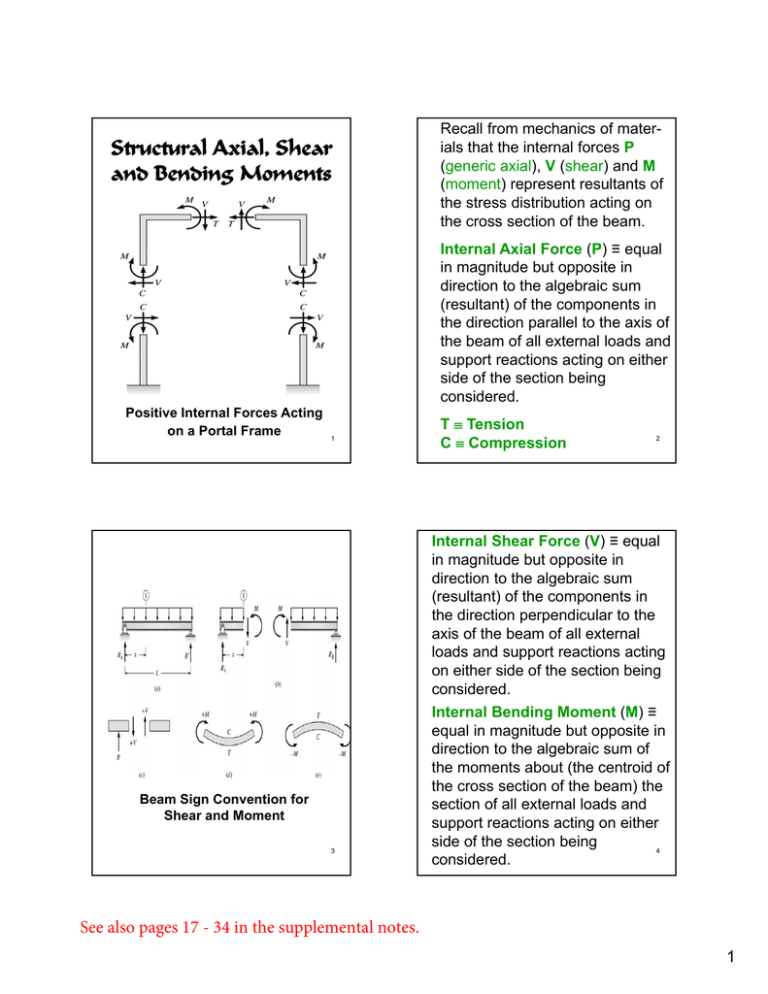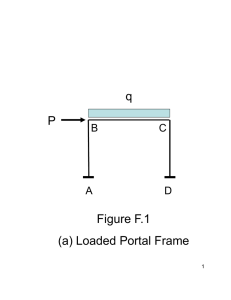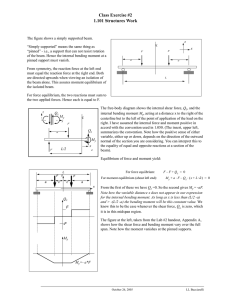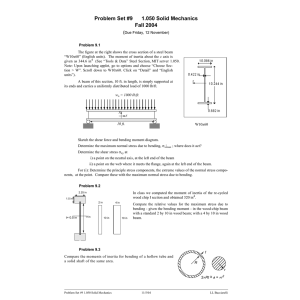Structural Axial, Shear and Bending Moments
advertisement

Structural Axial, Shear and Bending Moments Recall from mechanics of materials that the internal forces P (generic axial), V (shear) and M (moment) represent resultants of the stress distribution acting on the cross section of the beam. Internal Axial Force (P) ≡ equal in magnitude but opposite in direction to the algebraic sum (resultant) of the components in the direction parallel to the axis of the beam of all external loads and support reactions acting on either side of the section being considered. Positive Internal Forces Acting on a Portal Frame 1 T Tension C Compression 2 Internal Shear Force (V) ≡ equal in magnitude but opposite in direction to the algebraic sum (resultant) of the components in the direction perpendicular to the axis of the beam of all external loads and support reactions acting on either side of the section being considered. Beam Sign Convention for Shear and Moment 3 Internal Bending Moment (M) ≡ equal in magnitude but opposite in direction to the algebraic sum of the moments about (the centroid of the cross section of the beam) the section of all external loads and support reactions acting on either side of the section being 4 considered. See also pages 17 - 34 in the supplemental notes. 1 Positive Sign Conventions: Tension axial force on the section Shears that produces clockwise moments Bending moments that produce compression in the top fibers and tension in the bottom fibers of the beam 5 Shear and bending moment diagrams depict the variation of these quantities along the length of the member. Proceeding from one end of the member to the other, sections are passed. After each successive change in loading along the length of the member, a FBD (Free Body Diagram) is drawn to determine the equations expressing the shear and bending moment in terms of the distance from a convenient origin. Plotting these equations produces the shear and bending moment 6 diagrams. Zero Shear Maximum Positive Bending Moment V and M are in the opposite directions of the positive beam sign convention Shear and Bending Moment Diagrams 7 8 2 Principle of Superposition Example Problem Shear and Moment Diagrams Calculate and draw the shear force and bending moment equations for the given structure. 9 Sketching the Deflected Shape of a Beam or Frame Qualitative Deflected Shape (elastic curve) ≡ a rough (usually exaggerated) sketch of the neutral surface of the structure in the deformed position under the action of a given loading condition. 10 Following our positive beam sign convention, a positive bending moment bends a beam concave upward (or towards the positive y direction), whereas a negative bending moment bends a beam concave downward (or towards the negative y direction). Such sketches provide valuable insights into the behavior of structures. 11 12 3 An accurate sketch must satisfy the following rules: • The curvature must be consistent with the moment curve. • The deflected shape must satisfy the boundary constraints. • The original angle at a rigid joint must be preserved. • The length of the deformed member is the same as the original length of the unloaded member. 13 14 •The horizontal projection of a beam or the vertical projection of a column is equal to the original length of the member. •Axial deformations, which are trivial compared to bending deformations, are neglected. P.I. Point of Inflection = zero moment location for mechanically loaded structures 15 16 4 BC = zero member bending B'C' – straight line (linear) since MBC = 0 17 18 Ignoring zero displacement at C Enforcing zero displacement at C 19 Bending displacements without support conditions 20 5 BB’ = CC’ = ’A from Fig. (a) Note discontinuity in rotation at C – internal hinge location DD” = DD’ + A’A from Fig. (a) Enforcing support conditions NOTE: Members AB’ and C’D” displacements are linear since the bending moment in these members is zero 21 22 Axial Force, Shear Force and Bending Moment Diagrams for Plane Frames Previous definitions developed for shear forces and bending moments are valid for both beam and frame structures. However, application of these definitions, developed for a horizontal beam, to a frame structure will require some adjustments. Consider the portal frame shown on the next two slides. 23 q P B A C D Figure F.1 (a) Loaded Portal Frame 24 6 BC MC M BC B TBBC VCBC VBBC TCBC TCCD VCCD M CD C TBAB VBAB M AB B F.1 (b) M AB A AB VA AB TA M CD D CD VD CD TD The positive sign convention consistent with beam theory is shown in F.1(b). As seen from F.1 (b), the positive sign convention is (a) tension axial force, (b) shear forces that produce clockwise moments and (c) bending moments that result in tension stresses in the interior frame fibers. The sign convention of F.1(b) can be seen to be equivalent to the beam sign convention rotating columns AB and CD to line up with beam BC. 25 NOTE: For multi-bay frames, the usual practice is to define tension axial forces and shears that produce clockwise moments as positive for each member. However, the inside fiber for bending is not easily defined. Consequently, engineers choose to draw the bending moments on either the tension (common amongst structural engineers) or compression side of the members. They are not labeled as either positive or negative. Alternatively, a vector sign convention can be used – usual 27 for computer codes. 26 Example Frame Problem 1 Calculate and draw the axial force, shear force and bending moment equations for the given 28 frame structure. 7 Example Frame Problem 2 Two-Dimensional Force Transformations Py Px FT (a) r y Pt x Pn Calculate and draw the axial force, shear force and bending moment equations for the given 29 frame structure. Suppose you are given the forces in FT (a) and you wish to transform these forces into Pn (normal) and Pt (tangential) as shown in FT (b). This force transformation may be necessary so that you can calculate the member axial and shear forces. These force transformations are summarized on the next slide. FT (b) FT = Force Transformation Py 30 Pn Px Pn Px sin Py cos Pt Px cos Py sin Pt Py Px cos x ; r tan 31 y x sin y ; r 32 8 Example Frame with Inclined Member Degree of Frame Indeterminacy Rigid Frame ≡ composed of straight members connected either by rigid (moment resisting) connections or by hinged connections to form stable configurations. Rigid Joint ≡ prevents relative translations and rotations between connected members. Calculate and draw the axial force, shear force and bending 33 moment equations. Statically Determinate ≡ the bending moments, shears, and axial forces in all its members, as well as the external reactions, can be determined by using the equations of equilibrium and condition, otherwise the frame is either unstable or statically indeterminate. 34 Summary 3m + R < 3j + C statically unstable frame 3m + R = 3j + C statically determinate frame, if stable 3m + R > 3j + C statically indeterminate frame, if stable I = (3m + R) - (3j + C) = degree of static indeterminacy 35 Redundants ≡ excess members and reactions 36 9 Alternative Approach An alternative approach for determining the degree of static indeterminacy of a frame is to cut enough members of the frame by passing imaginary sections and/or to remove enough supports to render the structure statically determinate. The total number of internal and external restraints thus removed equals the degree of static indeterminacy. This alternative approach provides the most convenient means for determining the degree of static indeterminacy of multistory building frames: I = 3(Ng – Nf) – Nh – 2Nr – C Ng ≡ Number of Girders in the structure Nf ≡ Number of Free joints in the structure Nh ≡ Number of Hinged supports Nr ≡ Number of Roller supports 37 Equations of Condition at a Joint Detail w/ Three or More Members C ≡ Number of equations of Condition in the structure 38 m = 5, R = 8 j = 6, C = 0 I=5 m = 4, R = 3 j = 4, C = 0 I=3 m = 6, R = 4 j = 6, C = 0 Cj = Nbj – 1 Nbj = Number of Beam (moment resisting) members at joint j 39 I=4 I = (3m + R) – (3j + C) 40 10 m = 10, R = 9 j = 9, C = 5 Ng = 4, Nf = 0 Nh = Nr = 0 I=7 Ng = 4, Nf = 0 Nh = Nr = 0 Ng = 35, Nf = 0 Nh = Nr = 0 C=0 C=0 I = 12 I = 105 I = 3(Ng – Nf) – Nh – 2Nr - C 41 42 11





